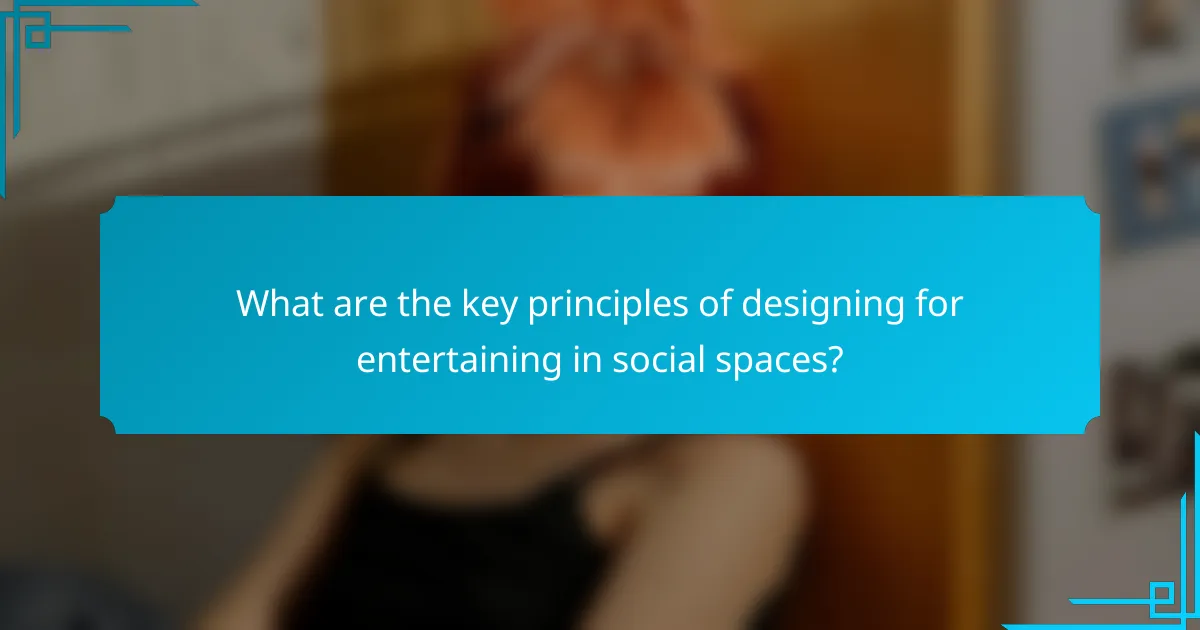Designing for entertaining in social spaces involves key principles that enhance guest experiences, including creating an inviting atmosphere, ensuring accessibility, and facilitating interaction. Effective layout ideas, such as open floor plans and circular seating arrangements, promote social engagement and movement among guests. Lighting and decor play critical roles in setting the mood and enhancing the overall ambiance, while thoughtful arrangements of furniture and food stations improve accessibility and flow. By implementing these strategies, hosts can create memorable and enjoyable gatherings that cater to all attendees.

What are the key principles of designing for entertaining in social spaces?
The key principles of designing for entertaining in social spaces include creating an inviting atmosphere, ensuring accessibility, and facilitating interaction. An inviting atmosphere can be achieved through appropriate lighting, comfortable seating, and appealing decor. Accessibility is crucial; spaces should accommodate all guests, including those with mobility challenges. Facilitating interaction involves arranging furniture to promote conversation and connection. Additionally, incorporating flexible layouts allows for adaptability during various events. These principles enhance the overall experience, making social gatherings enjoyable and memorable.
How do layout and flow impact social interactions?
Layout and flow significantly impact social interactions by influencing how people navigate and engage within a space. An open layout encourages movement and facilitates conversations. It allows individuals to easily approach one another without barriers. In contrast, a closed or cluttered layout can create obstacles that hinder interaction. Flow refers to the ease with which people can move through a space. A well-planned flow guides visitors naturally from one area to another. Research shows that spaces designed with clear pathways increase social engagement. According to a study by the Journal of Environmental Psychology, environments that promote visibility and accessibility enhance social interactions. Thus, thoughtful layout and flow are crucial for fostering meaningful connections in social settings.
What are the essential elements of a well-designed social space?
A well-designed social space includes comfort, functionality, and aesthetics. Comfort is achieved through appropriate seating arrangements and temperature control. Functional layouts facilitate easy movement and interaction among guests. Aesthetics enhance the visual appeal through color schemes, lighting, and decor. These elements work together to create an inviting atmosphere. Research shows that well-designed spaces promote social interaction and improve overall satisfaction. For instance, a study by the American Society of Interior Designers highlights the impact of layout on social engagement.
How can furniture arrangement enhance the flow of a space?
Furniture arrangement enhances the flow of a space by creating clear pathways and facilitating movement. Strategic placement of furniture allows for unobstructed traffic patterns. This arrangement encourages social interaction and engagement among guests. Open spaces promote a sense of comfort and accessibility. Research indicates that well-structured layouts can improve functionality by up to 30%. Additionally, using furniture to define areas can enhance the overall ambiance. Proper spacing between pieces reduces clutter and creates a welcoming environment. Ultimately, thoughtful furniture arrangement directly impacts the usability of a space.
What considerations should be made for different types of gatherings?
Different types of gatherings require specific considerations for successful execution. The size of the gathering dictates space requirements and seating arrangements. For formal events, seating should facilitate conversation and engagement. Informal gatherings benefit from open layouts that encourage mingling.
Catering options must align with the gathering type. Buffet-style works well for casual events, while plated meals suit formal occasions.
Audio-visual needs vary by gathering type. Presentations require equipment for visibility and sound, while social events may need background music.
Accessibility is crucial for all gatherings. Ensure pathways are clear and facilities are accessible for everyone.
Decor should reflect the event’s theme and tone. Formal gatherings often use elegant decor, while casual events can embrace playful elements.
Safety measures must be in place, including crowd control and emergency exits.
Lastly, consider the time of day for lighting and ambiance. Daytime events may utilize natural light, while evening gatherings require strategic lighting for mood.
How do the needs of a casual gathering differ from a formal event?
Casual gatherings require a relaxed atmosphere, while formal events demand structure and etiquette. Casual settings often prioritize comfort and informality, allowing for flexible seating arrangements and a variety of activities. In contrast, formal events typically feature designated seating, a set agenda, and adherence to specific dress codes. Casual gatherings may include casual dining options, such as finger foods or buffet-style service. Formal events usually involve a sit-down meal with multiple courses and formal service. Additionally, casual gatherings focus on social interaction and entertainment, while formal events often emphasize speeches, presentations, or ceremonies. These differences highlight the distinct needs of each type of gathering in terms of layout, food, and overall experience.
What role does the size of the space play in designing for entertaining?
The size of the space significantly influences the design for entertaining. Larger spaces allow for more guests and varied seating arrangements. They can accommodate activities such as dining, dancing, and games. Smaller spaces require more strategic layouts to maximize comfort and interaction. In limited areas, multifunctional furniture can optimize usability. According to a study by the American Society of Interior Designers, well-planned layouts enhance guest experience. Effective use of space can lead to improved social interaction and enjoyment. The size also affects acoustics, lighting, and overall ambiance. These elements are crucial for creating an inviting environment for social gatherings.

What are some effective layout ideas for entertaining spaces?
Effective layout ideas for entertaining spaces include creating open floor plans. Open layouts promote movement and social interaction among guests. Arrange seating in a circular or semi-circular formation to encourage conversation. This setup allows guests to easily engage with one another. Incorporate multi-functional furniture to maximize space utility. For instance, use ottomans that can serve as seating and storage. Place food and drink stations strategically to facilitate easy access. This ensures guests can serve themselves without disrupting conversations. Use area rugs to define different zones within the space. This helps in organizing activities and creating a cozy atmosphere. Finally, consider the flow of traffic to prevent congestion during gatherings. Clear pathways enhance guest mobility and comfort.
How can open floor plans facilitate social interactions?
Open floor plans facilitate social interactions by creating an unobstructed space that encourages communication. These layouts eliminate barriers, allowing people to see and hear each other easily. This visibility fosters engagement and connection among individuals. Research indicates that open spaces can lead to increased collaboration and interaction. A study published in the Journal of Environmental Psychology found that open office designs enhance social interactions by 20%. Open floor plans also promote a sense of community, making gatherings more inclusive and enjoyable. Overall, the design encourages a fluid movement between areas, enhancing the social atmosphere.
What are the advantages of using zones in an entertaining space?
Using zones in an entertaining space enhances functionality and improves guest experience. Zones allow for distinct areas tailored to different activities, such as dining, lounging, and games. This organization promotes social interaction by encouraging guests to engage in various activities. Research indicates that well-defined zones can increase the perceived spaciousness of a room. According to a study by the American Society of Interior Designers, spaces with clear zones lead to higher satisfaction among guests. Additionally, zoning can facilitate better traffic flow, reducing congestion during gatherings. Overall, the use of zones creates a more dynamic and enjoyable environment for entertaining.
How can pathways be designed to promote movement and engagement?
Pathways can be designed to promote movement and engagement by ensuring they are wide enough to accommodate foot traffic. A width of at least 6 feet is recommended for busy areas to allow for comfortable movement. Incorporating curves and varied elevations can create visual interest and encourage exploration. Adding seating areas along pathways invites people to pause and engage with their surroundings. Integrating natural elements, such as plants or water features, enhances the sensory experience and encourages interaction. Clear signage and wayfinding elements help guide users and reduce confusion. Research shows that well-designed pathways can increase foot traffic by up to 30%, enhancing overall engagement in social spaces.
What are the best furniture arrangements for various social settings?
The best furniture arrangements for various social settings include open layouts, conversational clusters, and flexible seating. Open layouts facilitate movement and interaction, making them ideal for larger gatherings. Conversational clusters, with seating arranged around a central point, encourage intimate discussions. Flexible seating allows for easy reconfiguration, adapting to different group sizes. These arrangements enhance social flow and engagement. Research by the American Society of Interior Designers highlights that well-planned layouts improve guest interaction and satisfaction.
How can seating arrangements encourage conversation?
Seating arrangements can encourage conversation by promoting proximity and eye contact among participants. Arranging seats in a circular or semi-circular layout fosters inclusivity and engagement. This configuration allows everyone to see each other, reducing barriers to interaction. Studies show that people are more likely to converse when they are facing one another. Additionally, using smaller clusters of seating can create intimate settings that invite deeper discussions. Open layouts without large tables can facilitate movement and interaction between groups. The presence of comfortable seating can also make individuals feel more relaxed, further enhancing conversation flow.
What types of tables work best for different entertaining scenarios?
Dining tables are best for formal dinners and large gatherings. They provide ample space for food and conversation. Coffee tables work well for casual get-togethers and relaxed settings. They allow easy access to snacks and drinks. Bar tables are ideal for cocktail parties and social events. Their height encourages mingling and movement. Side tables suit smaller gatherings or intimate settings. They can hold drinks or appetizers without overwhelming the space. Console tables are great for entryways or as serving stations. They maximize space while providing functionality. Each table type enhances the entertaining experience based on the scenario.

How can lighting and decor enhance the entertaining experience?
Lighting and decor significantly enhance the entertaining experience by creating an inviting atmosphere. Proper lighting sets the mood for gatherings, influencing emotions and interactions. Warm lighting can promote relaxation, while brighter lights can energize the space. Decor elements like color schemes and textures add visual interest and cohesiveness. For instance, using seasonal decor can make events feel special and themed. Studies show that well-designed environments can increase guest satisfaction and engagement. Therefore, thoughtful lighting and decor choices are essential for successful entertaining.
What role does lighting play in setting the mood for gatherings?
Lighting plays a crucial role in setting the mood for gatherings. It influences the atmosphere and emotional response of guests. Soft, warm lighting creates a cozy and inviting environment. Bright, harsh lighting can make a space feel sterile and unwelcoming. The color temperature of the light also affects mood; warmer tones promote relaxation. Dimming lights during dinner enhances intimacy and conversation. According to a study by the Lighting Research Center, lighting can impact social interactions and the overall enjoyment of an event. Proper lighting design can elevate the experience and encourage engagement among attendees.
How can different lighting techniques be applied in social spaces?
Different lighting techniques can enhance the ambiance and functionality of social spaces. Ambient lighting provides overall illumination, creating a welcoming environment. Task lighting focuses on specific areas, aiding activities such as dining or games. Accent lighting highlights features like artwork or architectural elements, adding visual interest. Layering these techniques creates depth and versatility in the lighting scheme. For example, a restaurant may use dimmable ambient lights, table lamps for task lighting, and spotlights for artwork. Studies show that well-planned lighting can improve mood and social interaction, making spaces more enjoyable.
What types of decor can elevate the atmosphere of a gathering?
Lighting can significantly elevate the atmosphere of a gathering. Soft, warm lighting creates an inviting ambiance. String lights or candles add a cozy touch. Centerpieces enhance table aesthetics and draw attention. Floral arrangements bring freshness and color to the space. Thematic decor aligns with the event’s purpose, making it more engaging. Textiles, such as tablecloths and cushions, add comfort and style. Wall art or banners can personalize the environment and express creativity. Each of these decor types contributes to a more enjoyable and memorable experience for guests.
How can technology be integrated into entertaining spaces?
Technology can be integrated into entertaining spaces through various methods. Smart lighting systems can create ambiance and set the mood. Audio systems can provide high-quality sound for music or entertainment. Interactive displays can showcase visual content or facilitate games. Smart home devices can control temperature and lighting remotely. Virtual reality setups can offer immersive experiences for guests. Wi-Fi connectivity ensures seamless access to online content. Mobile apps can enhance guest interaction and engagement. These integrations enhance the overall experience and enjoyment in social gatherings.
What are the benefits of smart home technology for social gatherings?
Smart home technology enhances social gatherings by improving convenience, ambiance, and security. Automated lighting can be adjusted to create the perfect atmosphere for different events. Smart speakers provide high-quality audio for music or announcements, enhancing the overall experience. Temperature control systems ensure comfort for guests regardless of the weather. Smart home devices can also facilitate seamless interaction, allowing hosts to manage everything from a central hub. Additionally, security features provide peace of mind, ensuring that the gathering space is safe. Studies show that homes equipped with smart technology often see increased guest satisfaction and engagement.
How can audio-visual setups improve the entertaining experience?
Audio-visual setups enhance the entertaining experience by creating immersive environments. High-quality visuals capture attention and engage viewers. Surround sound systems provide an auditory experience that complements visual elements. This combination stimulates multiple senses, increasing emotional involvement. Research shows that immersive experiences can boost enjoyment and retention. For example, a study by the University of Southern California found that participants rated their enjoyment 30% higher in immersive environments. Effective audio-visual setups also facilitate social interaction, making gatherings more enjoyable. Overall, they transform ordinary events into memorable experiences.
What are some practical tips for designing versatile entertaining spaces?
Use flexible furniture to create versatile entertaining spaces. Opt for pieces that can be easily rearranged. Sectional sofas can adapt to different layouts. Folding tables allow for varying guest capacities. Incorporate multifunctional items, like storage ottomans. Use rugs to define areas without permanent walls. Ensure ample lighting options for different moods. Create open pathways for smooth traffic flow.
The main entity of the article is the design of social spaces for entertaining. The article outlines key principles for creating inviting and accessible environments that facilitate interaction among guests. It discusses the impact of layout and flow on social interactions, emphasizing the importance of furniture arrangement, lighting, and decor in enhancing the overall experience. Additionally, it provides practical tips for designing versatile spaces that cater to different types of gatherings, ensuring comfort and engagement. The article also highlights the role of technology and audio-visual setups in improving the entertaining experience.